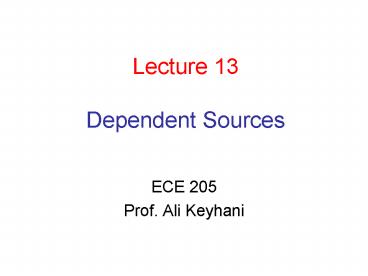Lecture 13 Dependent Sources - PowerPoint PPT Presentation
1 / 18
Title:
Lecture 13 Dependent Sources
Description:
Active Device: Device that are dependent on an external power supply to operate ... (CCCS) Voltage Controlled Current Source (VCCS) Dependent Sources ... – PowerPoint PPT presentation
Number of Views:107
Avg rating:3.0/5.0
Title: Lecture 13 Dependent Sources
1
Lecture 13Dependent Sources
- ECE 205
- Prof. Ali Keyhani
2
Active Devices
- Active Device Device that are dependent on an
external power supply to operate - Active Circuit Circuits that contain one or more
active devices - Linearly active devices input-output
relationship of the active devices is governed by
the equation yKx - K is called the proportionality factor
3
Dependent Sources
- Linear active devices are usually modeled using
resistors and dependent sources - Dependent sources a voltage or current source
whose output is controlled by a voltage or
current in another part of the circuit - Depending on the type of the source and the
control there are four types of dependent sources
4
Dependent Sources
- Current Controlled Voltage Source (CCVS)
- Voltage Controlled Voltage Source
- (VCVS)
- Current Controlled Current Source
- (CCCS)
- Voltage Controlled Current Source
- (VCCS)
5
Dependent Sources
- All the linearly dependent sources have an output
proportional to the input current or voltage as
yKx - The proportionality factor is called gain in the
dependent sources - Voltage gain µ (dimensionless)
- Current gain ß (dimensionless)
- Transresistance (transfer resistance) r (ohm)
- Transconductance (transfer conductance)
g(siemens)
6
Circuit Analysis with Dependent Sources
- Turning on and off the dependent voltages sources
requires turning on and off their independent
sources - Superposition, source transformation and circuit
reduction also apply to active circuits
7
Example 1
- What is the output voltage, current and power?
8
- Current division to find ix
- Dependent voltage source
- Current division
9
- Input-output relationship of the circuit
- Signal inversion K-6000 which means input
and output have opposite signs - Output power
- Input power
10
- Power gain of the system is greater than one
11
Example 2
- Find the output voltage vo in terms of input
voltage vs.
12
Example 2
- Solution
13
Node Voltage Analysis with Dependent Sources
- To write the node voltage equations first the
dependent sources are treated as independent
sources - After writing the symmetrical equations the
dependent sources are expressed in terms of the
node voltages - The new sets of non-symmetrical equations are
solved to find the unknown node voltage equations
14
Example 3
- Formulate node-voltage equations
- Find vo and io in terms of is.
15
- Solution
- a) Symmetrical node-voltage equations
- Since vxvA the equations can be simplified
16
- vovB therefore by solving the equations the vB
is found
17
Mesh Current Analysis with Dependent Sources
- The same pattern as the node-voltage analysis is
followed - The mesh current equations are written as if the
sources are all independent - The dependent sources are then replaced by their
equivalent expression in terms of unknown mesh
currents
18
Example 4
- Find current io with mesh analysis.































